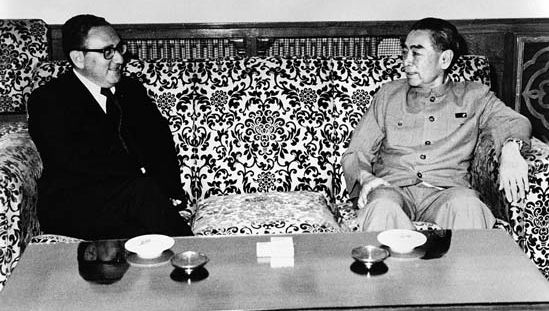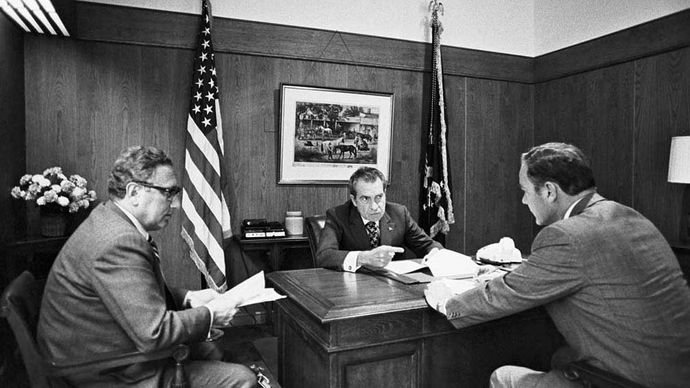Henry kissinger là ai
Bạn đang xem: Henry kissinger là ai
Corrections? Updates? Omissions? Let us know if you have sầu suggestions lớn improve sầu this article (requires login).
Feedbaông chồng TypeSelect a type (Required)Factual CorrectionSpelling/Grammar CorrectionLink CorrectionAdditional InformationOther
Our editors will review what you’ve sầu submitted và determine whether khổng lồ revise the article.
Join songbaivn.com"s Publishing Partner Program and our community of experts lớn gain a global audience for your work!
Henry Kissinger & Zhou Enlai
Henry Kissinger (left) meeting with Chinese Premier Zhou Enlai, 1971.
Xem thêm: Người Thi Hành Công Vụ Là Gì ? Birthright Citizenship In The United States
Nhà Trắng Photo
Although he originally advocated a hard-line policy in Vietphái mạnh và helped engineer the U.S. bombing of Cambodia (1969–70), Kissinger later played a major role in Nixon’s Vietnamization policy—the disengagement of U.S. troops from South Vietphái nam và their replacement by South Vietnamese forces. In 1972 Kissinger engaged in peace negotiations with Le Duc Tho of North Vietphái mạnh. Believing that these negotiations had reached a successful conclusion, on October 26 Kissinger announced that “peace was at hand.” It turned out, however, that the bilateral agreement had not been approved by the South Vietnamese government, and the peace efforts once more reached a stalemate. In mid-December Nixon authorized saturation bombing of North Vietnam, but by the over of the month he had halted it, và, with progress being made in the talks with North Vietnam giới in Paris, on January 15, 1973, Nixon ceased all military action against North Vietnam giới. Just over a week later, on January 23 in Paris, Kissinger initialed a cease-fire agreement that provided for the withdrawal of U.S. troops & outlined the machinery for a permanent peace settlement between the two Vietnams. In a news conference on January 24, which clarified the main points of the agreement, Kissinger said:

(From left) U.S. National Security Adviser Henry Kissinger, Pres. Richard Nixon, và Deputy National Security Adviser Alexander Haig discussing the Vietnam giới War in Nixon"s study at Camp David, Marylvà, November 13, 1972.
The United States is seeking a peace that heals. We have sầu had many armistices in Indochina. We want a peace that will last...therefore it is our firm intention in our relationship lớn the Democratic Republic of Vietphái nam lớn move from hostility to normalization, & from normalization to lớn conciliation and cooperation. And we believe sầu that under conditions of peace we can contribute throughout Indochimãng cầu to lớn a realization of the humane aspirations of all the people of Indochimãng cầu. And we will, in that spirit, perform our traditional role of helping people realize these aspirations in peace.
For this apparent resolution of the Vietnam conflict, Kissinger shared the 1973 Nobel Prize for Peace with Le Duc Tho (who refused the honour).
Xem thêm: 10 Tác Dụng Của Lá Vối & Cách Pha, 8+ Công Dụng Tuyệt Vời Bạn Cần Biết!
After the Arab-Israeli war of 1973 (see Yom Kippur War), Kissinger used what came khổng lồ be called shuttle diplomacy in disengaging the opposing armies & promoting a truce between the belligerents. He was responsible for the resumption of diplomatic relations between Egypt & the United States, severed since 1967. He remained in office after Nixon’s resignation in 1974, directing the conduct of foreign affairs under President Ford. After leaving office in 1977, Kissinger became an international consultant, writer, and lecturer. In 1983 U.S. Pres. Ronald Reagan appointed hyên khổng lồ head a national commission on Central America. In the 1980s he also served on the President’s Foreign Intelligence Advisory Board và the Commission on Integrated Long-Term Strategy. Kissinger’s later books included American Foreign Policy (1969), The Nhà Trắng Years (1979), For the Record (1981), Years of Upheaval (1982), Diplomacy (1994), Years of Renewal (1999), Does America Need a Foreign Policy?: Toward a Diplomacy for the 21st Century (2001), Ending the Vietphái mạnh War: A History of America’s Involvement in và Extrication from the Vietphái nam War (2003), Crisis: The Anatomy of Two Major Foreign Policy Crises (2003), On China (2011), and World Order (2014). With Eric Schmidt và Daniel Huttenlocher, he published The Age of AI: And Our Human Future (2021).